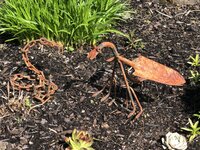- Messages
- 1,253
- Reactions
- 2,474
I live in snake central [Central CA].
Every year I see and hear of people getting bit. almost to the person they were playing with it or stepped on it.
The worst I have seen was a 10 year old kid who was playing paintball with his friends. He was bit mid calf by a big rattler. From that point on he did almost everything wrong!
He took off running for home, on a 105 degree day. By the time his friends caught up with him he had pumped the poison all through his body. They were playing in a place they were not supposed to be so they did not want to admit where they were, So they walked there friend a couple miles home. By the time they called for help their friend was in bad shape.
He spent a couple months in the hospital, and Dr's cut away 50% of his leg. That has been years ago and his leg still looks mangled.
I have also seen a lot of dogs, horses, and cattle that have been bit. usually they survive, but loose some skin to necrosis. Our vet said to give them a high dose of Benadryl, and keep them still and as cool as possible.
For some reason horses almost always get bit on the face or nose! It leaves them with nasty scars.
I have never been bit or even close. About the closest I have come, I was moving hay bales, and as I picked one up two big ones shot between my legs! I was so surprised they were gone before I was sure what happened.
My own avoidance has me never putting my feet or hands where I cant clearly see.
carry a walking stick and probe the grass ahead of you
Wear tall boots, and wear gloves.
And if your dogs start acting stupid don't run over there, but call your dogs away. DR
Every year I see and hear of people getting bit. almost to the person they were playing with it or stepped on it.
The worst I have seen was a 10 year old kid who was playing paintball with his friends. He was bit mid calf by a big rattler. From that point on he did almost everything wrong!
He took off running for home, on a 105 degree day. By the time his friends caught up with him he had pumped the poison all through his body. They were playing in a place they were not supposed to be so they did not want to admit where they were, So they walked there friend a couple miles home. By the time they called for help their friend was in bad shape.
He spent a couple months in the hospital, and Dr's cut away 50% of his leg. That has been years ago and his leg still looks mangled.
I have also seen a lot of dogs, horses, and cattle that have been bit. usually they survive, but loose some skin to necrosis. Our vet said to give them a high dose of Benadryl, and keep them still and as cool as possible.
For some reason horses almost always get bit on the face or nose! It leaves them with nasty scars.
I have never been bit or even close. About the closest I have come, I was moving hay bales, and as I picked one up two big ones shot between my legs! I was so surprised they were gone before I was sure what happened.
My own avoidance has me never putting my feet or hands where I cant clearly see.
carry a walking stick and probe the grass ahead of you
Wear tall boots, and wear gloves.
And if your dogs start acting stupid don't run over there, but call your dogs away. DR













